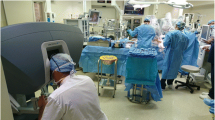Abstract
Background
Robotic endoscopic coronary artery bypass grafting procedures usually are performed as solo surgery operations. This study aimed to investigate whether manual assistance can reduce suturing times and anastomotic suturing problems in robotic coronary artery surgery.
Methods
In isolated pig hearts, the right coronary artery was excised from the epicardium as a pedicle. This pedicled vessel, which resembles the internal mammary artery, was sutured to the left anterior descending artery using the daVinci telemanipulation system. The anastomosis was performed in a running fashion using 7/0 Pronova. In group 1 (n = 20), the suture was performed by the console surgeon as a solo operation. In group 2 (n = 20), the anastomosis was assisted by a team member using an endo forceps. The operations were performed by five surgeons of different training levels.
Results
The overall anastomotic time was 24 ± 15 min in group 1 and 22 ± 12 min in group 2. The difference was not significant. The rate for anastomotic suturing problems (thread rupture, knot formation, sling formation, needle bending) was 8 in 20 (40%) in group 1 and 8 in 20 (40%) in group 2 (no difference). Anastomotic times and anastomotic suturing errors were dependent on surgeon experience. All anastomoses in both groups showed correct suture alignment and were probe patent.
Conclusion
In a wet lab model of robotic coronary anastomoses, assisting maneuvers do not decrease suturing speed. Similar suturing quality can be achieved whether the suture is performed in a solo fashion or in an assisted manner.




Similar content being viewed by others
References
Bonatti J, Schachner T, Bernecker O, Chevtchik O, Bonaros N, Ott H, Friedrich G, Weidinger F, Laufer G (2004) Robotic totally endoscopic coronary artery bypass: program development and learning curve issues. J Thorac Cardiovasc Surg 127: 504–510
Bonatti J, Schachner T, Bonaros N, Öhlinger A, Danzmayr M, Jonetzko P, Friedrich G, Kolbitsch Ch, Mair P, Laufer G (2006) Technical challenges in totally endoscopic robotic coronary artery bypass grafting. J Thorac Cardiovasc Surg 131: 146–153
Dogan S, Aybek T, Andressen E, Byhahn C, Mierdl S, Westphal K, Matheis G, Moritz A, Wimmer-Greinecker G (2002) Totally endoscopic coronary bypass grafting on cardiopulmonary bypass with robotically enhanced telemanipulation: report of forty-five cases. J Thorac Cardiovasc Surg 123: 1125–1131
Dogan S, Aybek T, Risteski P, Mierdl S, Stein H, Herzog C, Khan MF, Dzemali O, Moritz A, Wimmer Greinecker G (2004) Totally endoscopic coronary artery bypass graft: initial experience with an additional instrument arm and an advanced camera system. Surg Endosc 18: 1587–1591
Falk V, Diegeler A, Walther T, Banusch J, Brucerius J, Raumans J, Autschbach R, Mohr FW (2000) Total endoscopic computer-enhanced coronary artery bypass grafting. Eur J Cardiothorac Surg 17: 38–45
Falk V, Gummert JF, Walther T, Hayase M, Berry GJ, Mohr FW (1999) Quality of computer-enhanced totally endoscopic coronary bypass graft anastomoses: comparison to conventional techniques. Eur J Cardiothorac Surg 15: 260–265
Kappert U, Schneider J, Cichon R, Gulielmos V, Tugtekin SM, Nicolai J, Matschke K, Schueler S (2001) Development of robotic-enhanced endoscopic surgery for the treatment of coronary artery disease. Circulation 104(Suppl 1): I-102–I-107
Loulmet D, Carpentier A, d’Attellis N, Berrebi A, Cardon C, Ponzio O, Aupecle B, Relland JY (1999) Endoscopic coronary artery bypass grafting with the aid of robotic assisted instruments. J Thorac Cardiovasc Surg 118: 4–10
Author information
Authors and Affiliations
Corresponding author
Rights and permissions
About this article
Cite this article
Bonatti, J., Alfadlhi, J., Schachner, T. et al. Do manual assisting maneuvers increase speed and technical performance in robotically sutured coronary bypass graft anastomoses?. Surg Endosc 21, 1715–1718 (2007). https://doi.org/10.1007/s00464-007-9233-9
Received:
Revised:
Accepted:
Published:
Issue Date:
DOI: https://doi.org/10.1007/s00464-007-9233-9




